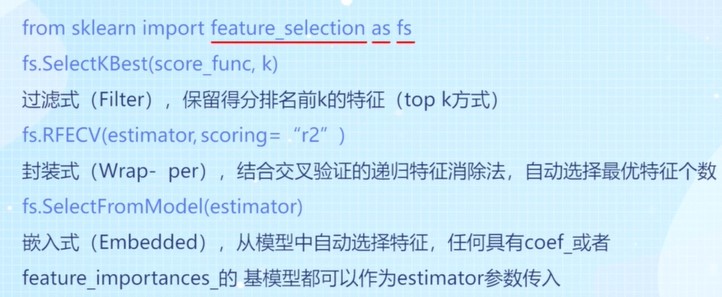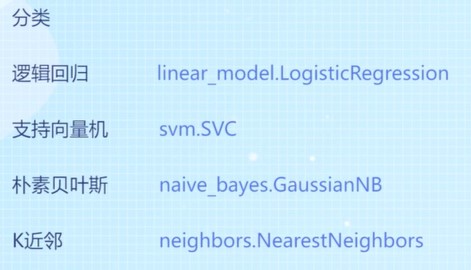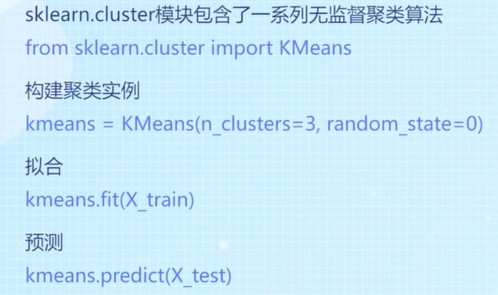机器学习库Scikit-learn
本博文基于温州大学黄海广机器学习慕课(https://www.icourse163.org/learn/WZU-1464096179?tid=1466943454#/learn/announce)进行知识梳理。
Scikit-learn概述
包括分类、回归、降维、聚类四大机器学习算法;包括特征提取、数据处理、模型评估三大模块。

Scikit-learn主要用法
符号标记:

无监督学习的话就没有标签(y)
基本建模流程
- 导入工具包
from sklearn import datasets,preprocessing
from sklearn.model_selection import train_test_split
from sklearn.linear_model import LinerRegression(线性回归)
from sklearn.metrics import r2_score
- 加载数据
支持Numpy的arrays对象、Pandas对象、SciPy的稀疏矩阵及其他可转换为数值型arrays的数据结构。数据必须是数值型的。
提供了一系列加载和获取著名数据集,如鸢尾花(分类)、波士顿房价(回归)、Olivetti人脸(人脸识别)、MNIST(图像)数据集等的工具。
# 鸢尾花数据集
from sklearn.datasets import load_iris
iris=load_iris()
X=iris.data
y=iris.target
- 数据划分
from sklearn.model_selection import train_test_split
X_train,X_test,y_train,y_test=train_test_split(X,y,random_state=12,stratify=y,test_size=0.3)
# 70%作为训练集,30%作为测试集;stratify=y表示各类别数据的比例与原始数据集比例一致;可通过shuffle=True提前打乱数据。(随机性大些)
- 数据预处理
# 使用Scikit_learn进行数据标准化
from sklearn.preprocessing import StandardScaler
# 构建转换器实例
scaler=StandardScaler()
# 拟合及转换
scaler.fit_transform(X_train)

- 特征选择

监督学习算法
回归

分类

clf 一般代表分类器;max_depth 具体的参数;y_pred 直接预测出属于哪一类;y_prob直接预测出概率。

集成学习

无监督学习算法
聚类


评价指标

accuracy_score 准确率:y_true真实标签/y_pred预测标签
回归的评价指标

用法:y_true真实标签 和 y_pred预测标签 带入
分类的评价指标

超参数调优
交叉验证

网格搜索——速度非常慢

随机搜索

Scikit-learn案例代码实现
建立简单机器学习的方法
在数据集上训练和测试一个分类器。划分数据后,使用fit方法学习机器学习模型,使用score方法测试此方法依赖于默认的准确度指标。
import matplotlib.pyplot as plt
from sklearn.datasets import load_digits
X, y = load_digits(return_X_y=True)
print(X.shape) # (1797, 64)
# X中的每行包含64个图像像素的强度。 对于X中的每个样本,我们得到表示所写数字对应的y。
# 绘制灰度图
plt.imshow(X[0].reshape(8, 8), cmap='gray')# 灰度显示图像
plt.axis('off')# 关闭坐标轴
print('The digit in the image is {}'.format(y[0]))# 格式化打印
plt.show()
# 划分数据
from sklearn.model_selection import train_test_split
X_train, X_test, y_train, y_test = train_test_split( X, y, stratify=y, test_size=0.25, random_state=42)
# 划分数据为训练集与测试集,添加stratify参数使得训练和测试数据集的类分布与整个数据集的类分布相同。
from sklearn.linear_model import LogisticRegression # 求出Logistic回归的精确度得分
clf = LogisticRegression(solver='lbfgs', multi_class='ovr', max_iter=5000, random_state=42)
clf.fit(X_train, y_train)
accuracy = clf.score(X_test, y_test)
print('Accuracy score of the {} is {:.4f}'.format(clf.__class__.__name__, accuracy))
# Accuracy score of the LogisticRegression is 0.9622
from sklearn.ensemble import RandomForestClassifier
# RandomForestClassifier轻松替换LogisticRegression分类器
clf = RandomForestClassifier(n_estimators=1000, n_jobs=-1, random_state=42)
clf.fit(X_train, y_train)
accuracy = clf.score(X_test, y_test)
print('Accuracy score of the {} is {:.2f}'.format(clf.__class__.__name__, accuracy))
# Accuracy score of the RandomForestClassifier is 0.97
from xgboost import XGBClassifier
clf = XGBClassifier(n_estimators=1000)
clf.fit(X_train, y_train)
accuracy = clf.score(X_test, y_test)
print('Accuracy score of the {} is {:.2f}'.format(clf.__class__.__name__, accuracy))
# Accuracy score of the XGBClassifier is 0.96
from sklearn.ensemble import GradientBoostingClassifier
clf = GradientBoostingClassifier(n_estimators=100, random_state=0)
clf.fit(X_train, y_train)
accuracy = clf.score(X_test, y_test)
print('Accuracy score of the {} is {:.2f}'.format(clf.__class__.__name__,accuracy))
# Accuracy score of the GradientBoostingClassifier is 0.96
from sklearn.metrics import balanced_accuracy_score
y_pred = clf.predict(X_test)
accuracy = balanced_accuracy_score(y_pred, y_test)
print('Accuracy score of the {} is {:.2f}'.format(clf.__class__.__name__, accuracy))
# Accuracy score of the GradientBoostingClassifier is 0.96
from sklearn.svm import SVC
clf = SVC()
clf.fit(X_train, y_train)
accuracy = clf.score(X_test, y_test)
print('Accuracy score of the {} is {:.2f}'.format(clf.__class__.__name__,accuracy))
# Accuracy score of the SVC is 0.99
from sklearn.svm import LinearSVC
clf = LinearSVC()
clf.fit(X_train, y_train)
accuracy = clf.score(X_test, y_test)
print('Accuracy score of the {} is {:.2f}'.format(clf.__class__.__name__,accuracy))
# Accuracy score of the LinearSVC is 0.93
数据预处理
规范化数据
from sklearn.datasets import load_digits
X, y = load_digits(return_X_y=True)
# 划分数据
from sklearn.model_selection import train_test_split
X_train, X_test, y_train, y_test = train_test_split( X, y, stratify=y, test_size=0.25, random_state=42)
# 划分数据为训练集与测试集,添加stratify参数使得训练和测试数据集的类分布与整个数据集的类分布相同。
from sklearn.preprocessing import MinMaxScaler # 归一化数据
from sklearn.svm import LinearSVC
scaler = MinMaxScaler()
X_train_scaled = scaler.fit_transform(X_train) # 标准用法
X_test_scaled = scaler.transform(X_test) # 标准用法
clf = LinearSVC()
clf.fit(X_train_scaled, y_train)
accuracy = clf.score(X_test_scaled, y_test)
print('Accuracy score of the {} is {:.2f}'.format(clf.__class__.__name__,accuracy))
# Accuracy score of the LinearSVC is 0.97
from sklearn.preprocessing import StandardScaler # 标准化数据
scaler = StandardScaler()
X_train_scaled = scaler.fit_transform(X_train)
X_test_scaled = scaler.transform(X_test)
clf = LinearSVC()
clf.fit(X_train_scaled, y_train)
accuracy = clf.score(X_test_scaled, y_test)
print('Accuracy score of the {} is {:.2f}'.format(clf.__class__.__name__,accuracy))
# Accuracy score of the LinearSVC is 0.95
错误的规范化方式:
- 未切分数据之前就做了规范化
- 独立的标准化训练集和测试集(都用了fit_transform),造成数据分布不一致。
正确的用法:
X_train_scaled = scaler.fit_transform(X_train) # 标准用法
X_test_scaled = scaler.transform(X_test) # 标准用法
管道连接器_流水线方法
规范化数据会产生数据泄露的问题,引入Pipeline对象,导入管道流水线,依次连接多个转换器和分类器(或回归器)。
from sklearn.datasets import load_digits
X, y = load_digits(return_X_y=True)
# 划分数据
from sklearn.model_selection import train_test_split
X_train, X_test, y_train, y_test = train_test_split( X, y, stratify=y, test_size=0.25, random_state=42)
# 划分数据为训练集与测试集,添加stratify参数使得训练和测试数据集的类分布与整个数据集的类分布相同。
from sklearn.preprocessing import MinMaxScaler
from sklearn.linear_model import LogisticRegression
from sklearn.pipeline import Pipeline
pipe=Pipeline(steps=[('scaler',MinMaxScaler()),
('clf',LogisticRegression(solver='lbfgs',multi_class='auto',random_state=42))])
pipe.fit(X_train,y_train)
accuracy=pipe.score(X_test,y_test)
print('Accuracy score of the {} is {:.2f}'.format(pipe.__class__.__name__,accuracy))
# Accuracy score of the Pipeline is 0.96
管道包含了归一化和分类器的参数,但有时,为管道中的每个估计器命名会很繁琐,make_pipeline将自动为每个估计器命名。
from sklearn.pipeline import make_pipeline
pipe=make_pipeline(MinMaxScaler(),LogisticRegression(solver='lbfgs',multi_class='auto',random_state=42,max_iter=1000))
检查管道的所有参数get_params()
clf.get_params()
pipe.get_params()
grid.get_params()
上述采用:
print(pipe.get_params())
# {'memory': None, 'steps': [('minmaxscaler', MinMaxScaler()), ('logisticregression', LogisticRegression(max_iter=1000, random_state=42))],
# 'verbose': False, 'minmaxscaler': MinMaxScaler(), 'logisticregression': LogisticRegression(max_iter=1000, random_state=42), 'minmaxscaler__clip': False,
# 'minmaxscaler__copy': True, 'minmaxscaler__feature_range': (0, 1), 'logisticregression__C': 1.0, 'logisticregression__class_weight': None,
# 'logisticregression__dual': False, 'logisticregression__fit_intercept': True, 'logisticregression__intercept_scaling': 1, 'logisticregression__l1_ratio': None,
# 'logisticregression__max_iter': 1000, 'logisticregression__multi_class': 'auto', 'logisticregression__n_jobs': None, 'logisticregression__penalty': 'l2',
# 'logisticregression__random_state': 42, 'logisticregression__solver': 'lbfgs', 'logisticregression__tol': 0.0001, 'logisticregression__verbose': 0, 'logisticregression__warm_start': False}
交叉验证和调整参数
交叉验证
分割数据对于评估统计模型性能是必要的,但它减少了可用于学习模型的样本数量。 因此,应尽可能使用交叉验证。有多个拆分也会提供有关模型稳定性的信息。
scikit-learn提供了三个函数:cross_val_score,cross_val_predict和cross_validate。 后者提供了有关拟合时间,训练和测试分数的更多信息。 可以一次返回多个分数。
from sklearn.datasets import load_digits
X, y = load_digits(return_X_y=True)
# 划分数据
from sklearn.model_selection import train_test_split
X_train, X_test, y_train, y_test = train_test_split( X, y, stratify=y, test_size=0.25, random_state=42)
# 划分数据为训练集与测试集,添加stratify参数使得训练和测试数据集的类分布与整个数据集的类分布相同。
from sklearn.preprocessing import StandardScaler # 标准化数据
from sklearn.linear_model import LogisticRegression
scaler = StandardScaler()
X_train_scaled = scaler.fit_transform(X_train)
X_test_scaled = scaler.transform(X_test)
clf = LogisticRegression(
solver='lbfgs', multi_class='auto', max_iter=1000, random_state=42)
clf.fit(X_train_scaled, y_train)
# 三则交叉验证
from sklearn.model_selection import cross_validate
scores = cross_validate(
clf, X_train_scaled, y_train, cv=3, return_train_score=True)
# 也可以先用管道,再交叉验证,将clf变为pipe。
import pandas as pd
df_scores = pd.DataFrame(scores)
print(df_scores)
# fit_time score_time test_score train_score
# 0 0.048182 0.000998 0.975501 1.0
# 1 0.044217 0.000000 0.957684 1.0
# 2 0.060272 0.000997 0.962138 1.0
超参数调优
目前主要有 3 种最流行的超参数调整技术:网格搜索、随机搜索和贝叶斯搜索,其中Scikit-learn内置了网格搜索、随机搜索。
网格搜索
通过参数网络进行交叉验证的网格搜索
from sklearn.model_selection import GridSearchCV
clf = LogisticRegression(
solver='saga', multi_class='auto', random_state=42, max_iter=5000)
param_grid = { 'logisticregression__C': [0.01, 0.1, 1],'logisticregression__penalty': ['l2', 'l1']}
tuned_parameters = [{'C': [0.01, 0.1, 1, 10],'penalty': ['l2', 'l1']}]
grid = GridSearchCV(clf, tuned_parameters, cv=3, n_jobs=-1, return_train_score=True)
grid.fit(X_train_scaled, y_train)
df_grid = pd.DataFrame(grid.cv_results_)
print(df_grid)
# mean_fit_time std_fit_time ... mean_train_score std_train_score
# 0 0.778660 0.035975 ... 0.953229 0.000909
# 1 1.391996 0.238394 ... 0.539718 0.007571
# 2 2.445325 0.156810 ... 0.988122 0.001389
# 3 10.451066 1.570733 ... 0.956570 0.004167
# 4 5.899076 0.727554 ... 1.000000 0.000000
# 5 27.624908 0.899765 ... 0.999258 0.000525
# 6 13.274437 0.871355 ... 1.000000 0.000000
# 7 23.585131 2.492550 ... 1.000000 0.000000
# [8 rows x 18 columns]
# {'C': 1, 'penalty': 'l2'}
我们只对单个分割进行网格搜索,我们可能会进行外部交叉验证,以估计模型的性能和不同的数据样本,并检查性能的潜在变化。网格搜索是一个估计器,可以直接在cross_validate 函数中使用它。
from sklearn.model_selection import cross_validate
scores=cross_validate(grid,X,y,cv=3,n_jobs=-1,return_train_score=True)
df_scores=pd.DataFrame(scores)
print(df_scores)
流水线操作
管道——流水线操作:数据的规范化、导入模型、网格搜索、交叉验证
from sklearn.datasets import load_digits
X, y = load_digits(return_X_y=True)
# 划分数据
from sklearn.model_selection import train_test_split
X_train, X_test, y_train, y_test = train_test_split( X, y, stratify=y, test_size=0.25, random_state=42)
# 划分数据为训练集与测试集,添加stratify参数使得训练和测试数据集的类分布与整个数据集的类分布相同。
# 管道——流水线操作:数据的规范化、导入模型、网格搜索、交叉验证
import pandas as pd
from sklearn.preprocessing import MinMaxScaler
from sklearn.linear_model import LogisticRegression
from sklearn.pipeline import make_pipeline
from sklearn.model_selection import GridSearchCV
from sklearn.model_selection import cross_validate
X = X_train
y = y_train
pipe = make_pipeline( MinMaxScaler(),LogisticRegression( solver='saga', multi_class='auto', random_state=42, max_iter=5000))
param_grid = { 'logisticregression__C': [0.1, 1.0, 10],'logisticregression__penalty': ['l2', 'l1']}
grid = GridSearchCV(pipe, param_grid=param_grid, cv=3, n_jobs=-1)
scores = pd.DataFrame(cross_validate(grid, X, y, cv=3, n_jobs=-1, return_train_score=True))
# scores[['train_score', 'test_score']].boxplot()
import matplotlib.pyplot as plt
plt.boxplot(scores[['train_score', 'test_score']])
plt.grid()
plt.show()
pipe.fit(X_train, y_train)
accuracy = pipe.score(X_test, y_test)
print('Accuracy score of the {} is {:.2f}'.format(pipe.__class__.__name__, accuracy))
# Accuracy score of the Pipeline is 0.96

箱线图:
- ① 箱子的中间一条线,是数据的中位数,代表了样本数据的平均水平。
- ② 箱子的上下限,分别是数据的上四分位数和下四分位数。这意味着箱子包含了50%的数据。因此,箱子的宽度在一定程度上反映了数据的波动程度。
- ③ 在箱子的上方和下方,又各有一条线。有时候代表着最大最小值,有时候会有一些点“冒出去”。请千万不要纠结,不要纠结,不要纠结(重要的事情说三遍),如果有点冒出去,理解成“异常值”就好。





















 874
874











 被折叠的 条评论
为什么被折叠?
被折叠的 条评论
为什么被折叠?








